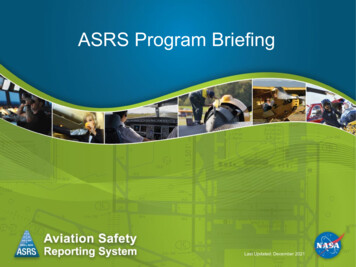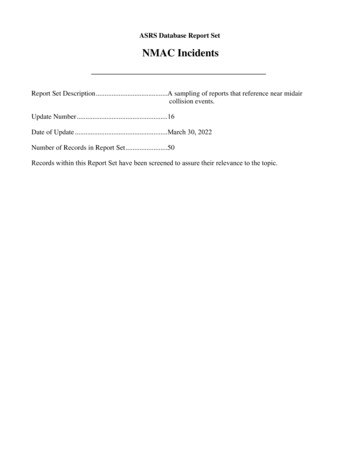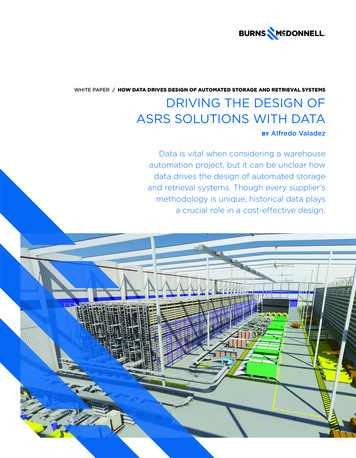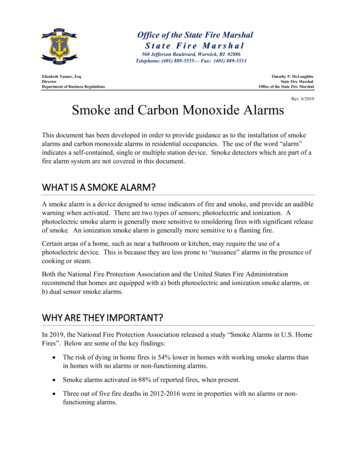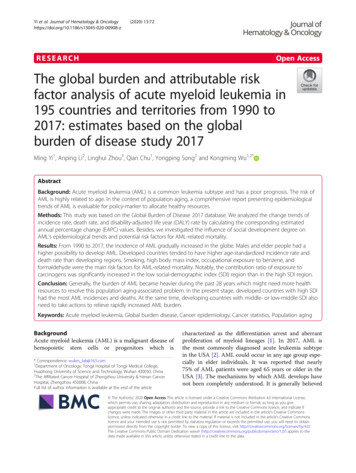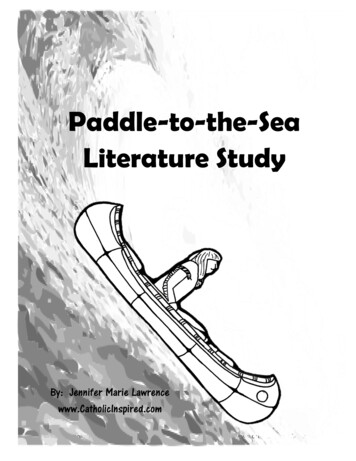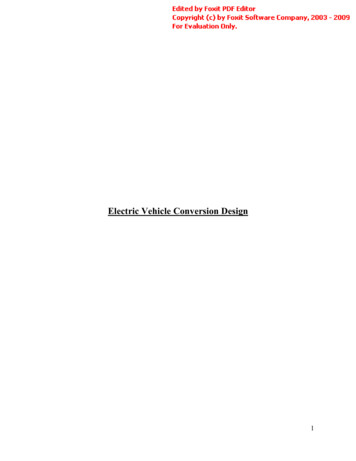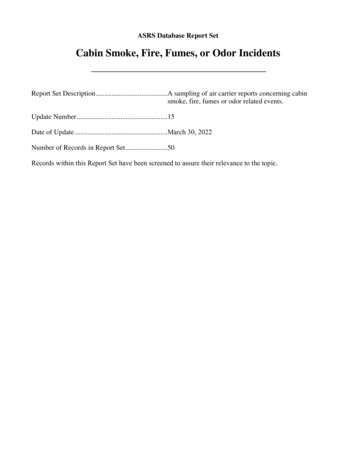
Transcription
ASRS Database Report SetCabin Smoke, Fire, Fumes, or Odor IncidentsReport Set Description .A sampling of air carrier reports concerning cabinsmoke, fire, fumes or odor related events.Update Number .15Date of Update .March 30, 2022Number of Records in Report Set .50Records within this Report Set have been screened to assure their relevance to the topic.
National Aeronautics andSpace AdministrationAmes Research CenterMoffett Field, CA 94035-1000TH: 262-7MEMORANDUM FOR: Recipients of Aviation Safety Reporting System DataSUBJECT: Data Derived from ASRS ReportsThe attached material is furnished pursuant to a request for data from the NASA Aviation SafetyReporting System (ASRS). Recipients of this material are reminded when evaluating these dataof the following points.ASRS reports are submitted voluntarily. Such incidents are independently submitted and are notcorroborated by NASA, the FAA or NTSB. The existence in the ASRS database of reportsconcerning a specific topic cannot, therefore, be used to infer the prevalence of that problemwithin the National Airspace System.Information contained in reports submitted to ASRS may be clarified by further contact with theindividual who submitted them, but the information provided by the reporter is not investigatedfurther. Such information represents the perspective of the specific individual who is describingtheir experience and perception of a safety related event.After preliminary processing, all ASRS reports are de-identified and the identity of theindividual who submitted the report is permanently eliminated. All ASRS report processingsystems are designed to protect identifying information submitted by reporters; including names,company affiliations, and specific times of incident occurrence. After a report has been deidentified, any verification of information submitted to ASRS would be limited.The National Aeronautics and Space Administration and its ASRS current contractor, BoozAllen Hamilton, specifically disclaim any responsibility for any interpretation which may bemade by others of any material or data furnished by NASA in response to queries of the ASRSdatabase and related materials.Becky L. Hooey, DirectorNASA Aviation Safety Reporting System
CAVEAT REGARDING USE OF ASRS DATACertain caveats apply to the use of ASRS data. All ASRS reports are voluntarily submitted, andthus cannot be considered a measured random sample of the full population of like events. Forexample, we receive several thousand altitude deviation reports each year. This number maycomprise over half of all the altitude deviations that occur, or it may be just a small fraction oftotal occurrences.Moreover, not all pilots, controllers, mechanics, flight attendants, dispatchers or otherparticipants in the aviation system are equally aware of the ASRS or may be equally willing toreport. Thus, the data can reflect reporting biases. These biases, which are not fully known ormeasurable, may influence ASRS information. A safety problem such as near midair collisions(NMACs) may appear to be more highly concentrated in area “A” than area “B” simply becausethe airmen who operate in area “A” are more aware of the ASRS program and more inclined toreport should an NMAC occur. Any type of subjective, voluntary reporting will have theselimitations related to quantitative statistical analysis.One thing that can be known from ASRS data is that the number of reports received concerningspecific event types represents the lower measure of the true number of such events that areoccurring. For example, if ASRS receives 881 reports of track deviations in 2010 (this number ispurely hypothetical), then it can be known with some certainty that at least 881 such events haveoccurred in 2010. With these statistical limitations in mind, we believe that the real power ofASRS data is the qualitative information contained in report narratives. The pilots,controllers, and others who report tell us about aviation safety incidents and situations in detail –explaining what happened, and more importantly, why it happened. Using report narrativeseffectively requires an extra measure of study, but the knowledge derived is well worth the addedeffort.
Report Synopses
ACN: 1862240(1 of 50)SynopsisB737-800 Flight Attendant reported a fumes event during preflight while using ground AC.Passengers and flight crew deplaned.ACN: 1861535(2 of 50)SynopsisB737 Flight Attendant reported being notified by pilots of a "slight odor" due to an aircraftissue. Reporter stated the odor was very noticeable when flight deck door was openedduring deplaning at destination.ACN: 1861521(3 of 50)SynopsisAir Carrier Flight Attendant reported a "strange musty odor" during taxi. Flight returned togate and did not take aircraft to destination.ACN: 1861506(4 of 50)SynopsisCRJ-900 Flight Attendant reported an odor onboard the aircraft.ACN: 1860109(5 of 50)SynopsisAir Carrier flight crew reported a fumes event during preflight while executing a specialprocedure for operating ground air and starting engines. After a delay the flight ultimatelydeparted.ACN: 1859339(6 of 50)SynopsisAir Carrier Pilot reported Flight Attendant informed flight crew of "manure-like" odor inpassenger cabin during climb. Flight crew secured Pack 2 which caused the odor to
dissipate. After conferring with Dispatch and Maintenance the flight continued todestination.ACN: 1859003(7 of 50)SynopsisAir Carrier Captain reported a Flight Attendant notified the flight crew on three occasionsof fumes in the passenger cabin. Upon arrival Captain entered the discrepancy in theaircraft logbook.ACN: 1858535(8 of 50)SynopsisAir Carrier flight crew reported a fumes event during takeoff which dissipated after climbpower was set. Flight crew continued to destination where maintenance met the aircraft.ACN: 1858505(9 of 50)SynopsisAir Carrier Captain reported a fumes event during cruise. Flight crew diverted to a suitableairport.ACN: 1858276(10 of 50)SynopsisAir Carrier Flight Attendant crew reported a fume event which caused the cabin crew toexperience physiological symptoms. At destination, arrival Maintenance removed aircraftfrom service.ACN: 1857568(11 of 50)SynopsisAir Carrier Captain reported a fumes event during preflight. The aircraft was assigned toMaintenance and was dispatched hours later with different crew.ACN: 1857053(12 of 50)
SynopsisAir carrier flight crew reported a fumes event during cruise. After troubleshooting flightcrew executed a safe mechanical diversion.ACN: 1856542(13 of 50)SynopsisAir Carrier Captain reported a fume event during gate pushback resulting in a tow back tothe gate for passenger deplaning. Maintenance assigned an aircraft swap and flightcontinued with a normal departure.ACN: 1856272(14 of 50)SynopsisAir Carrier flight crew reported a fume event during boarding. Maintenance investigatedand placed the aircraft out of service. Flight continued after aircraft swap.ACN: 1856154(15 of 50)SynopsisAir Carrier Captain reported Baggage Smoke EICAS warning during cruise. Flight crewexecuted a diversion to nearest suitable airport and completed a safe overweight landing.ACN: 1856146(16 of 50)SynopsisAir Carrier Captain reported a transient fume event during takeoff. Odor described asmoderate to strong dirty socks which dissipated within 10 minutes.ACN: 1855376(17 of 50)SynopsisA320 Captain reported a fume event of "dirty socks" during descent that lasted until gatearrival.ACN: 1855375(18 of 50)
SynopsisA320 First Officer reported flight attendant notification of a fume event after landing.ACN: 1854677(19 of 50)SynopsisA321 flight attendants reported a fumes event during cruise. Flight attendants were metby paramedics upon gate arrival to evaluate physiological symptoms.ACN: 1854639(20 of 50)SynopsisA319 flight crew reported a fumes event of unknown cause during taxi-out and executed areturn to gate.ACN: 1854625(21 of 50)SynopsisA321 flight crew reported flight attendant notification of an "acrid smell" which dissipatedand reoccurred. Flight continued to destination where Medical and Maintenance wererequested.ACN: 1854468(22 of 50)SynopsisA320 Captain reported a temporary fumes event of "dirty socks" smell during landingapproach. Odor returned at gate arrival.ACN: 1854462(23 of 50)SynopsisAir Carrier flight crew reported flight attendant notification of "faint smoke smell" in cabin.Flight crew completed a safe air return.ACN: 1854433(24 of 50)
SynopsisAir Carrier pilot reported a fume event during taxi out and also during descent fordestination. Aft flight attendant experienced physiological symptoms.ACN: 1854150(25 of 50)SynopsisB737 Flight Attendant reported a fumes event after takeoff described as a "dirty socks"smell.ACN: 1853938(26 of 50)SynopsisEMB-145 First Officer reported a fumes event during taxi-out.ACN: 1853725(27 of 50)SynopsisA320 Captain reported a fumes event during pre-flight.ACN: 1853717(28 of 50)SynopsisA320 flight crew reported a "dirty sock" fumes event during idle power descent.ACN: 1853713(29 of 50)SynopsisA320 Captain reported a fumes event during pre-flight after APU bleeds were activated.ACN: 1853436Synopsis(30 of 50)
Cessna 525 Captain reported rejecting the takeoff after experiencing directional controldifficulties on the takeoff roll. Crew evacuated the aircraft after the Tower advised aircraftwas on fire.ACN: 1853379(31 of 50)SynopsisA319 flight crew reported a Cargo Smoke ECAM message and began checklist operations.Ground personnel signaled to shut down APU and APU auto shutdown. Passengers wereremoved from aircraft.ACN: 1853375(32 of 50)SynopsisA320 Captain reported a fumes event during cruise requiring one Flight Attendant to beput on oxygen.ACN: 1853312(33 of 50)SynopsisAir Carrier flight crew reported a fume event during cruise that was detected by flightattendants and passengers.ACN: 1853077(34 of 50)SynopsisA319 Flight Attendant reported notifying Captain of a fumes event during climb.ACN: 1853014(35 of 50)SynopsisA320 pilot reported multiple fumes events on assigned aircraft. Reporter suggested thereneeds to be collaboration between the FAA, Aircraft manufacturer, and Air Carrier toremedy frequent fume events.ACN: 1852849(36 of 50)
SynopsisA320 Captain reported a fumes event during pre-flight. After a lengthy maintenance delay,Pack #2 was deferred and the flight departure.ACN: 1852843(37 of 50)SynopsisAir Carrier Pilot reported a fume event during descent. Flight crew continued to a safelanding and submitted a logbook entry.ACN: 1852842(38 of 50)SynopsisA320 flight attendants reported a cabin fumes event during cruise. The flight crew andGate Agent also reported that the fumes were still noticeable after arrival at the gate.ACN: 1852785(39 of 50)SynopsisPilot reported that a passenger reported smoke in the cabin during cruise. The pilotelected to secure the cabin pack and the smoke dissipated. Pilot elected to divert andmake a precautionary landing.ACN: 1852663(40 of 50)SynopsisSR22 pilot reported smoke in the cabin due to a failed PFD panel.ACN: 1852636(41 of 50)SynopsisPilot flying C-182 aircraft reported an electrical burning odor during descent to landing.After landing inspection revealed electrical burn marks around hot terminal of alternator.ACN: 1852599(42 of 50)
SynopsisA319 flight attendant crew reported a fumes event during passenger boarding. Shortlythereafter, the Captain informed the crew to stop boarding and that maintenance wouldassign an aircraft swap.ACN: 1852448(43 of 50)SynopsisB787 flight crew reported a loss of cabin pressurization during climb that caused lingeringfumes from the overheated left Pack. Flight crew coordinated with ATC for an expedited airreturn which concluded in a safe landing.ACN: 1852364(44 of 50)SynopsisCitation Captain reported a baggage compartment smoke indication on descent. Afterlanding, an inspection did not find any evidence of smoke.ACN: 1852355(45 of 50)SynopsisA320 Flight Attendant reported a smoke and fumes event during departure.ACN: 1852345(46 of 50)SynopsisA321 flight attendants reported a fumes event described as a "chemical odor" duringapproach. Flight crew was immediately notified and the flight was met by Maintenance atgate arrival after a safe landing was accomplished.ACN: 1852079(47 of 50)SynopsisA320 pilot reported a "dirty socks" fumes event during passenger deplaning. Maintenancedetermined the fumes were caused by an APU oil leak.
ACN: 1852026(48 of 50)SynopsisAir Carrier flight crew reported a temporary fumes event after engine start. Fumesdissipated shortly thereafter. Discrepancy was noted in the aircraft logbook.ACN: 1851846(49 of 50)SynopsisTechnician reported burnt wires and evidence of arcing and fire in circuits associated withthe Avionics Vent Fan Blower. Reporter further stated he has now seen a total of fiveaircraft with similar damage.ACN: 1851403(50 of 50)SynopsisEMB-145 Captain reported a fumes event during cruise. Flight crew diverted to a suitablealternate for a safe landing.
Report Narratives
ACN: 1862240(1 of 50)Time / DayDate : 202111Local Time Of Day : 0601-1200PlaceLocale Reference.Airport : ZZZZ.AirportState Reference : FOAltitude.AGL.Single Value : 0AircraftReference : XATC / Advisory.Ground : ZZZZAircraft Operator : Air CarrierMake Model Name : B737-800Crew Size.Number Of Crew : 2Operating Under FAR Part : Part 121Flight Plan : IFRMission : PassengerFlight Phase : ParkedComponentAircraft Component : APUAircraft Reference : XProblem : FailedPersonLocation Of Person.Aircraft : XLocation In Aircraft : General Seating AreaCabin Activity : Safety Related DutiesCabin Activity : BoardingReporter Organization : Air CarrierFunction.Flight Attendant : Flight Attendant (On Duty)ASRS Report Number.Accession Number : 1862240Human Factors : Physiological - OtherEventsAnomaly.Aircraft Equipment Problem : Less SevereAnomaly.Flight Deck / Cabin / Aircraft Event : Smoke / Fire / Fumes / OdorAnomaly.Flight Deck / Cabin / Aircraft Event : Illness / InjuryAnomaly.Deviation / Discrepancy - Procedural : Published Material / PolicyDetector.Person : Flight AttendantWhen Detected : Aircraft In Service At GateResult.General : Flight Cancelled / DelayedResult.General : Maintenance ActionAssessmentsContributing Factors / Situations : AircraftPrimary Problem : Aircraft
Narrative: 1On ground in ZZZZ we were using ground AC and saw a little bit of haze in the cabin and itsmelled a little sulfur like. My throat is a little sore from the air. My head feels a little foggyand I have a slight headache. We got off the plane with all the passengers. We need tohave aircraft with a working APU when we fly somewhere hot. It's a safety issue to have aworking APU in hot locals. Especially when we all have to wear a mask. It makes you evenhotter. Don't send a plane that doesn't have a working APU to a hot location. Maybeairports should make sure their ground ac units are clean and not burning off anything.Maybe they need to be run regularly whether they get used or not.SynopsisB737-800 Flight Attendant reported a fumes event during preflight while using ground AC.Passengers and flight crew deplaned.
ACN: 1861535(2 of 50)Time / DayDate : 202111Local Time Of Day : 0601-1200PlaceLocale Reference.Airport : ZZZ.AirportState Reference : USAltitude.AGL.Single Value : 0AircraftReference : XATC / Advisory.Ground : ZZZAircraft Operator : Air CarrierMake Model Name : B737-800Crew Size.Number Of Crew : 2Operating Under FAR Part : Part 121Mission : PassengerFlight Phase : TaxiFlight Phase : CruiseFlight Phase : ParkedPersonLocation Of Person.Aircraft : XLocation In Aircraft : General Seating AreaCabin Activity : ServiceCabin Activity : Safety Related DutiesReporter Organization : Air CarrierFunction.Flight Attendant : Flight Attendant (On Duty)Qualification.Flight Attendant : CurrentASRS Report Number.Accession Number : 1861535EventsAnomaly.Aircraft Equipment Problem : Less SevereAnomaly.Flight Deck / Cabin / Aircraft Event : Smoke / Fire / Fumes / OdorAnomaly.Deviation / Discrepancy - Procedural : FARAnomaly.Deviation / Discrepancy - Procedural : Published Material / PolicyDetector.Person : Flight CrewDetector.Person : Flight AttendantWere Passengers Involved In Event : NWhen Detected : Aircraft In Service At GateWhen Detected : In-flightResult.Flight Crew : Overcame Equipment ProblemAssessmentsContributing Factors / Situations : AircraftPrimary Problem : AircraftNarrative: 1
Pilots let us know aircraft was not working properly and said there is a slight odor. Everyonce in a while, I could smell something different. But it was very noticeable when theflight deck door was open and during deplaning. Should not have let flight go with thisproblem. The flight should not have gone knowing there was an air problem.SynopsisB737 Flight Attendant reported being notified by pilots of a "slight odor" due to an aircraftissue. Reporter stated the odor was very noticeable when flight deck door was openedduring deplaning at destination.
ACN: 1861521(3 of 50)Time / DayDate : 202112Local Time Of Day : 0001-0600PlaceLocale Reference.Airport : ZZZ.AirportState Reference : USAltitude.AGL.Single Value : 0AircraftReference : XATC / Advisory.Ground : ZZZAircraft Operator : Air CarrierMake Model Name : A321Crew Size.Number Of Crew : 2Operating Under FAR Part : Part 121Mission : PassengerFlight Phase : TaxiComponentAircraft Component : Coalescer BagAircraft Reference : XProblem : MalfunctioningPersonLocation Of Person.Aircraft : XLocation In Aircraft : General Seating AreaCabin Activity : Safety Related DutiesReporter Organization : Air CarrierFunction.Flight Attendant : Flight Attendant (On Duty)Qualification.Flight Attendant : CurrentASRS Report Number.Accession Number : 1861521Human Factors : Other / UnknownHuman Factors : Communication BreakdownCommunication Breakdown.Party1 : Flight AttendantCommunication Breakdown.Party2 : MaintenanceEventsAnomaly.Aircraft Equipment Problem : Less SevereAnomaly.Flight Deck / Cabin / Aircraft Event : Smoke / Fire / Fumes / OdorAnomaly.Deviation / Discrepancy - Procedural : Published Material / PolicyAnomaly.Deviation / Discrepancy - Procedural : FARAnomaly.Deviation / Discrepancy - Procedural : MaintenanceDetector.Person : Flight CrewDetector.Person : Flight AttendantWhen Detected : TaxiResult.General : Work RefusedResult.Flight Crew : Returned To Gate
Result.Flight Crew : Requested ATC Assistance / ClarificationResult.Air Traffic Control : Provided AssistanceAssessmentsContributing Factors / SituationsContributing Factors / SituationsContributing Factors / SituationsContributing Factors / SituationsPrimary Problem : Aircraft::::AircraftCompany PolicyHuman FactorsProcedureNarrative: 1Aircraft X on Date was boarded with 2 passengers and taxied out. Apparently the nightbefore the same plane was cancelled due to fumes. On [that] morning we (crew of 5) weredeadheaded to ZZZ to take the same aircraft to ZZZ1. I do not understand whodetermined the aircraft was now safe to fly. The FO (First Officer) and FA's (FlightAttendants) smelled a strange musty odor on taxi out and returned to the gate. We did nottake the plane to ZZZ1. The decision made that the plane was indeed safe to fly whenthere were still fumes in the cabin.SynopsisAir Carrier Flight Attendant reported a "strange musty odor" during taxi. Flight returned togate and did not take aircraft to destination.
ACN: 1861506(4 of 50)Time / DayDate : 202112Local Time Of Day : 1201-1800AircraftReference : XAircraft Operator : Air CarrierMake Model Name : Regional Jet 900 (CRJ900)Crew Size.Number Of Crew : 2Operating Under FAR Part : Part 121Flight Plan : IFRMission : PassengerPersonLocation Of Person.Aircraft : XLocation In Aircraft : General Seating AreaCabin Activity : ServiceCabin Activity : Safety Related DutiesReporter Organization : Air CarrierFunction.Flight Attendant : Flight Attendant (On Duty)Qualification.Flight Attendant : CurrentASRS Report Number.Accession Number : 1861506EventsAnomaly.Aircraft Equipment Problem : Less SevereAnomaly.Flight Deck / Cabin / Aircraft Event : Smoke / Fire / Fumes / OdorAnomaly.Deviation / Discrepancy - Procedural : Published Material / PolicyAnomaly.Deviation / Discrepancy - Procedural : FARDetector.Person : Flight AttendantResult.General : None Reported / TakenAssessmentsContributing Factors / Situations : AircraftPrimary Problem : AircraftNarrative: 1Detected an odor onboard the aircraft.SynopsisCRJ-900 Flight Attendant reported an odor onboard the aircraft.
ACN: 1860109(5 of 50)Time / DayDate : 202111Local Time Of Day : 1201-1800PlaceLocale Reference.Airport : ZZZZ.AirportState Reference : FOAltitude.AGL.Single Value : 0AircraftReference : XAircraft Operator : Air CarrierMake Model Name : B737-800Crew Size.Number Of Crew : 2Operating Under FAR Part : Part 121Flight Plan : IFRMission : PassengerFlight Phase : ParkedComponentAircraft Component : APUAircraft Reference : XProblem : FailedPerson : 1Location Of Person.Aircraft : XLocation In Aircraft : Flight DeckReporter Organization : Air CarrierFunction.Flight Crew : Pilot FlyingFunction.Flight Crew : CaptainQualification.Flight Crew : MultiengineQualification.Flight Crew : Air Transport Pilot (ATP)Qualification.Flight Crew : InstrumentASRS Report Number.Accession Number : 1860109Human Factors : WorkloadHuman Factors : TroubleshootingHuman Factors : Communication BreakdownHuman Factors : DistractionCommunication Breakdown.Party1 : Flight CrewCommunication Breakdown.Party2 : Ground PersonnelPerson : 2Location Of Person.Aircraft : XLocation In Aircraft : Flight DeckReporter Organization : Air CarrierFunction.Flight Crew : First OfficerFunction.Flight Crew : Pilot Not FlyingQualification.Flight Crew : MultiengineQualification.Flight Crew : Air Transport Pilot (ATP)
Qualification.Flight Crew : InstrumentASRS Report Number.Accession Number : 1860077Human Factors : WorkloadHuman Factors : DistractionHuman Factors : Communication BreakdownHuman Factors : TroubleshootingCommunication Breakdown.Party1 : Flight CrewCommunication Breakdown.Party2 : Ground PersonnelEventsAnomaly.Aircraft Equipment Problem : Less SevereAnomaly.Flight Deck / Cabin / Aircraft Event : Smoke / Fire / Fumes / OdorAnomaly.Deviation / Discrepancy - Procedural : Published Material / PolicyAnomaly.Ground Event / Encounter : Other / UnknownDetector.Person : Flight CrewWhen Detected : Pre-flightResult.General : Flight Cancelled / DelayedResult.Flight Crew : Overcame Equipment ProblemAssessmentsContributing Factors / Situations : AircraftContributing Factors / Situations : Human FactorsPrimary Problem : AircraftNarrative: 1Aircraft X arrived in ZZZZ with a deferred APU bleed valve and was positioned at a ramplevel gate with portable ground equipment. During boarding, we discovered the need toadd an MEL requiring additional fuel, and were advised it would take an additional 20 minutes for the fuel truck to return. Cabin air temp was not being adequately maintainedby the ground air conditioning cart, so we elected to switch to the "huffer" external air cartto provide air to the packs for increased cooling during the additional delay. After severalattempts by the ground crew to get the cart to supply air, it began to provide adequate airsupply. Soon after, an acrid smell began to fill the cabin and a light haziness was visiblethroughout. We selected the packs off and asked the ground crew to turn the external aircart off. The decision was made to deplane due to poor air quality and rapidly increasingcabin temperature. Some difficulty was experienced communicating effectively with gateand ramp personnel to initiate this process. Once it was understood that this was bothnecessary and a priority, we were able to deplane without further incident. Dispatch,maintenance control, and the Chief Pilot were notified. After the airplane was inspected bymaintenance and returned to service, I verified with each crew member that they were notexperiencing any symptoms, felt in good health and verified verbally with each that theywere "fit to fly." No passengers indicated to the crew any physiological symptoms fromthis event. After a fresh aircraft security search was accomplished, Aircraft X, boarded anddeparted uneventfully. This event, while more nuisance than [critical]., required a greatdeal of crew interaction and awareness to overcome threats introduced by scheduledoperations with supplemental air systems and engine start procedures to a hot, humid,international environment. Decreased physical comfort, and barriers in communicatingwith ground personnel greatly increased workload. While I believe we ultimately managedthis situation thoroughly and appropriately, there is always a possibility that details couldhave been missed, mishandled, or not communicated to us along the way. Ultimately, myprimary recommendation is to avoid dispatching aircraft with deferred APU, APU bleedsource, or other [non-]dispatchable but nonetheless non-routine procedures to
destinations with extreme air temperatures, performance considerations, or regionaldifferences. When issues arise with seldom used ground equipment, cabin temperaturescan quickly become intolerable, creating an additional distraction for crews and anuncomfortable and potentially hazardous cabin environment for all. Additionally, thelanguage challenges introduced by international operations make communications duringnon-routine operations more difficult, exacerbating already challenging situations,increasing potential errors, and delaying efficient reaction to adverse situations. In ourcase, even while using simple, straight forward language, we were often having to repeatand reconfirm numerous times that individuals understood what was needed. This oftenled to delayed response and increased discomfort for our crew and guests.Narrative: 2While checking [initial flight release] at the hotel and in the van to the airport we noticedthat this aircraft, [Aircraft X] had [a] MEL for an inoperative APU bleed valve. Arriving atthe gate it was noticed that external air was not connected to the aircraft. Maybe therewas confusion by the ground crew who likely heard the APU and figured the cabin air wasbeing conditioned so we explained the need for a ground air conditioning cart to beconnected, and quickly. ZZZZ Operations complied and by the time we boarded theaircraft external air was connected. It was also apparent that operations did not know ofthe need for an external air cart to start engine #1. For reference the airplane was parkedat position XX with no jet way access. Checking the logbook we discovered the inboundcrew had to defer the B-System Autopilot with an MEL. Further inquiry into the MEL wenoticed the need for [an additional] MEL to also be applied for the Altitude AlertingSystem. This unfortunately prevented us from flying in RVSM airspace and required anadditional 1,000 pounds of fuel. Operations advised this was to going to take roughly 20minutes. At this point there were numerous complaints of excessive cabin temperature.We discussed and decided it was prudent to transition to the external air cart perSupplemental Procedure X.XX to operate the PACKS to try and cool the cabin. Conditionedground air was disconnected and the external air cart was connected. Unfortunately therewas confusion trying to get the air turned on which further heated the cabin. At about thepoint we were about to deplane due to excessive cabin heat the external air-cart began toprovide sufficient pressure to turn on and operate the PACKS. While the PACKS did beginto cool the cabin it did not take long for the two of us to notice both a strong acrid odorand a visible haze throughout the cabin. At this point we turned the PACKS off. While theodor did slowly begin to dissipate we felt strongly about having passengers disembark untilthe cabin temperature and air quality were under control. Naturally at this point the fueltruck arrived and station ops wanted us to quickly fuel and transition to starting theengines. We objected and a few minutes later passengers were headed into the terminal.We did not sense the need to evacuate given with the PACKS off the air quality wasstabilizing. At this point we felt it prudent to make a logbook entry for the air quality eventand felt we endured a Level 2-3 air quality contamination. Our suspicion was that thesource of the contamination was the external air cart and it likely having not been used inconjunction with the aircraft Pack's often in ZZZZ. Per Dispatch, Chief Pilot andmaintenance control advice we wanted to make sure that our suspicions were true andthat there was not an issue with the aircraft itself. The remainder of the events wereuneventful as we successfully started engines, ran the packs, observed aircraft cooling andimproved air quality. Unfortunately our flight was re-dispatched to ZZZ1 for late nightcustoms control and two new pilots with legal rest, but the customers all made it safely toZZZ2 at around XA:30am. I feel confident that our interactions as a crew ultimately led tothe right decisions being made. This scenario provided numerous distractions, namely theaddition of an MEL, additional fuel, non RVSM operations, a language barrier, excessivecabin heat, frequent calls from the cabin regarding potable water, starting an engine withan external air source and an air quality event. I feel our priorities never swayed from our
interest in passenger and crew safety and operating the aircraft in an airworthy fashion.That said this scenario provided numerous irregular operations and there is the potentialwe may not have thought of everything. I completely understand that aircraft schedulingis complex and not always visible to crews. That said, not having APU bleed air in atropic
dissipate. After conferring with Dispatch and Maintenance the flight continued to destination. ACN: 1859003 (7 of 50) Synopsis Air Carrier Captain reported a Flight Attendant notified the flight crew on three occasions of fumes in the passenger cabin. Upon arrival Captain entered the discrepancy in the aircraft logbook. ACN: 1858535 (8 of 50 .
